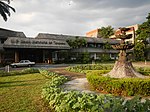Tandang Sora station

Tandang Sora station is an under-construction Metro Rail Transit (MRT) station located on the MRT Line 7 (MRT-7) system along Commonwealth Avenue in Matandang Balara and New Era, Quezon City. The Tandang Sora Flyover was demolished in March 2019 to give way for the construction of the MRT-7 station. Nearest landmarks include the Iglesia ni Cristo Central Temple, New Era University and Net 25 TV studios. The station is named after Melchora Aquino also known as Tandang Sora, one of the key personalities in the Philippine Revolution. This station should not be confused with the future Tandang Sora Station of the Metro Manila Subway Line 9, to be constructed at the corner of Tandang Sora Avenue and Mindanao Avenue, also in Quezon City. As of 31 January 2023, the project is 66.07% complete; the station's construction is planned to be finished by June of the same year.
Excerpt from the Wikipedia article Tandang Sora station (License: CC BY-SA 3.0, Authors, Images).Tandang Sora station
Commonwealth Avenue, Quezon City Diliman (4th District)
Geographical coordinates (GPS) Address Nearby Places Show on map
Geographical coordinates (GPS)
| Latitude | Longitude |
|---|---|
| N 14.66342 ° | E 121.06742 ° |
Address
Tandang Sora
Commonwealth Avenue
1101 Quezon City, Diliman (4th District)
Philippines
Open on Google Maps




